Table of Contents
The foundational principles that elucidate the dynamics between inputs and outputs in the creation of goods and services are known as The Laws of Production. These laws provide important insights into resource allocation, production efficiency, and the relationship between different factors of production. Among these laws, the Law of Returns to Scale highlights essential components that shape production processes and economic decision-making in the long run.
Law of Return to Scale Overview
The law of Production plays a critical role in economics by managing cost and producer equilibrium. It specifies the company’s multiple variable and fixed costs associated with the production output. The two laws of production are the Law of return to scale and the Law of variable proportion. The rules of production figure out the technologically possible methodologies of building up produce in a variety of ways.
What are the Laws of Production?
The laws of production in economics are associated with the concepts of cost and equilibrium of producers. It is an essential aspect of economics as it helps the company determine the level of production that results in maximum profit. It reflects the various fixed and variable costs of the business. There are two laws of production. These are two laws of production as mentioned below.
- Law of variable proportion
- Law of return to scale
Law of Return to Scale
As stated by Koutsoyiannis, the term “returns to scale” pertains to alterations in output when all factors undergo simultaneous proportional changes. According to Leibhafsky, “returns to scale” encompasses the overall output’s behaviour as all inputs are adjusted simultaneously, representing a concept applicable in the long run.
Types of Return to Scale
In the long run, the Law of Return to scale both the factors of production that is labour and capital are subject to change. In the below table, we can see that the labour units and capital are increasing. As a result, the total production is also changing but at a different rate. The three stages are explained below:
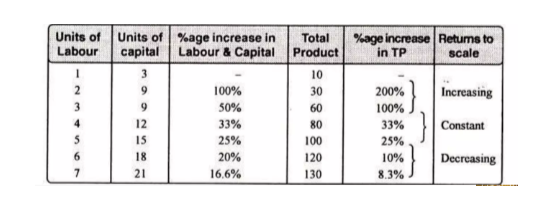
Increasing Returns to Scale or Diminishing Costs
- Increasing returns to scale, also known as diminishing costs, occur when boosting all production factors results in a greater-than-proportional surge in output.
- For instance, if inputs are doubled, the output grows more than twice as fast.
- This phenomenon, influenced by factors like division of labour and external economies of scale, can be visualized using Figure 8.
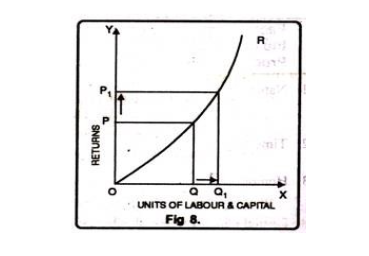
Illustrated in Figure 8, the X-axis (OX) denotes amplified labour and capital, while the Y-axis (OY) signifies heightened output. Upon elevating labour and capital from point Q to Q1, the output surges from point P to P1, surpassing the increment in labour and capital factors.
Constant Returns to Scale
- Constant returns to scale, or constant costs, emerge when output scales up in direct proportion to the enlargement of production factors.
- This equilibrium arises when economies of scale balance out diseconomies, typically occurring after a certain production threshold.
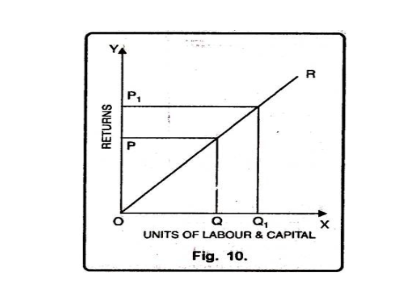
As showcased in Figure 10. This graphical representation depicts that an increase in labour and capital corresponds precisely to an equivalent increase in output, resulting in constant returns to scale.
Diminishing Returns to Scale
- Diminishing returns to scale, or rising costs, materialize when a consistent increase in all production factors leads to a proportionally smaller expansion in output.
- In essence, doubling inputs doesn’t lead to a doubling of output.
- This trend arises due to internal and external diseconomies outweighing economies. Figure 9 illustrates this pattern.
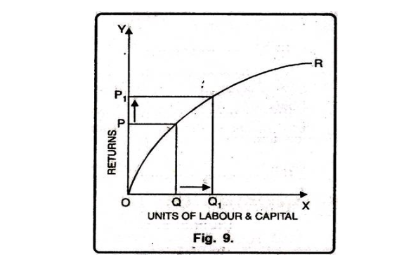
The X-axis (OX) symbolizes labour and capital quantities, while the Y-axis (OY) represents output. As factors of production surge from point Q to Q1 (higher quantity), the corresponding output increase from point P to P1 is relatively smaller. The outcome is that the increase in factors of production is more substantial compared to the increment in production, thus underscoring the presence of diminishing returns to scale.
Conclusion
Hence, the law of return to scale assists by providing a sound base upon which sound production strategies and economic policies are built. They guide producers and policymakers in making informed choices that optimize output, minimize costs, and foster sustainable growth in the long run.

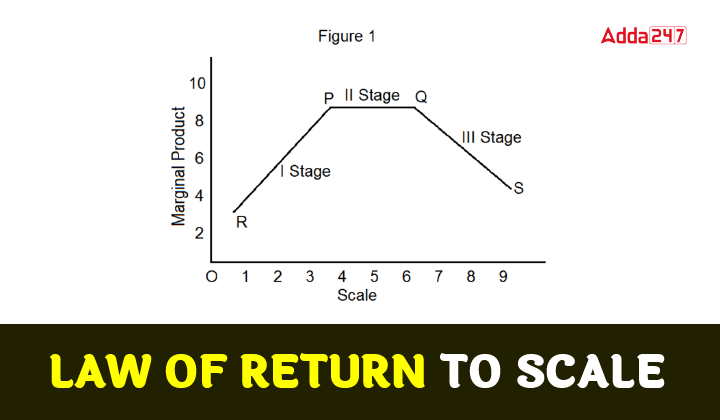

 UGC NET Exam City Intimation Slip 2025 O...
UGC NET Exam City Intimation Slip 2025 O...
 UGC NET Admit Card 2025 OUT, Download NT...
UGC NET Admit Card 2025 OUT, Download NT...
 Latest Job Alert for Teaching and UGC As...
Latest Job Alert for Teaching and UGC As...












